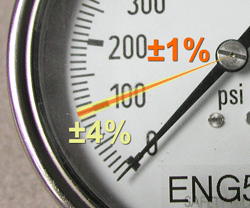When you send your tool to Duncan Aviation Calibration Services, we evaluate the Test Accuracy Ratio to ensure it is calibrated properly. If you are wondering, “What is a Test Accuracy Ratio?” You are not alone; we get this question from time to time.

TAR is the comparison between the accuracy of a tool (Unit Under Test or UUT) and the reference standard used to calibrate it. Metrology labs aim for a minimum TAR of 4:1, meaning the standard should be four times more accurate than the tool. A TAR of 1:1 means the tool and the standard have the same accuracy. If the TAR is less than 1:1 (like 0.5:1), the tool is more accurate than the standard.
For example, if a pressure gauge reads 100 psi with an accuracy of +/- 4 psi, the standard used to test it should have an accuracy of +/- 1 psi to maintain a 4:1 TAR. If 100 psi is applied to both, the tool can read between 96 and 104 psi and still be acceptable. The standard gauge must read between 99 and 101 psi to be acceptable.
The 4:1 TAR helps minimize errors from the reference standard. The higher the TAR, the fewer errors from the standard. Usually, this isn’t a problem, and our standards often achieve a TAR of 10:1 or even 1000:1.
In summary, TAR is a simple calculation to ensure the standard used for calibration is accurate enough for the tool being tested. Should our evaluation determine the TAR for the calibration is inadequate, we will notify you. We can offer sub-contracting services to ensure your tool is properly calibrated.
Duncan Aviation's Calibration Services offer test and calibration capabilities for a wide range of aircraft tools and instruments that routinely require calibration. Download the Duncan Aviation Calibrations Fact Sheet for a complete list of our calibration capabilities
SEND-IN TOOL CALIBRATION SERVICES
Need your tools back quickly? Call and send them to:
Duncan Calibrations Services, +1 402.479.1698
Calibration@DuncanAviation.com
Ship via FedEx (with special FedEx zip code) to:
Duncan Aviation Calibration Services
4001 N Park Rd
Lincoln, NE 68500
All other carriers ship to:
Duncan Aviation Calibration Services
4001 N Park Rd
Lincoln, NE 68524
Bringing your tools along to your next Duncan Aviation maintenance event can save you money on instrument calibrations.
 Scott Griess
Team Leader - Calibration Lab
Lincoln, NE (LNK)
+1 402.479.4272
Scott Griess
Team Leader - Calibration Lab
Lincoln, NE (LNK)
+1 402.479.4272
December 2025
November 2025
October 2025
August 2025
July 2025